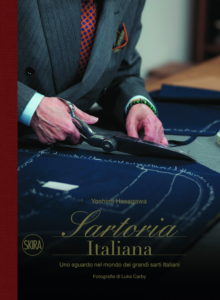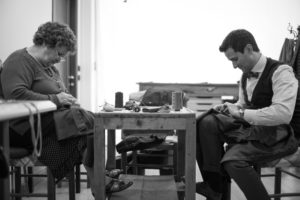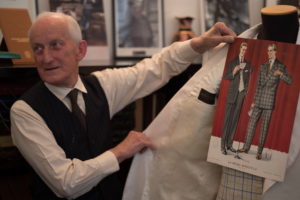You could ask how a book on tailoring fits into the fast-paced, tech-driven world of today – how is it relevant? Isn’t the craft dying out, or at best shrinking? What comes to mind when you think about a tailor, what is it you picture? An elderly gent in a cramped room marking fabric with tailor’s chalk or a well-suited slick salesman type with a tape measure around his neck? For those of us who don’t move in these circles we might imagine traditional tailoring to be an elitist world, operating in a male-dominated environment, full of bankers and city types swapping anecdotes and banter while having their inside leg measured – and you might not be far off the mark. A new book by Yoshimi Hasegawa opens the door on this exclusive world, dispelling some of the myths and giving us a rare look at Italian tailoring today.

The book is published in a time when the fashion industry is under scrutiny more than ever before. Documentaries and investigations are uncovering fashion’s dirty secrets, revealing the industry to be the world’s second biggest polluter after gas and coal. We’re hearing about surplus clothing being burned, and not just by fast fashion brands, in 2017 Burberry destroyed £28.6m worth of excess product. The industry is painfully aware of its negative impact on the planet, but it is looking to change. At the Copenhagen Fashion Summit 2017, 94 companies, including some of the big global players, signed a commitment to accelerate the industry’s transition to a circular fashion system. According to the Ellen MacArthur Foundation, circular production describes “…a restorative and regenerative system that uses innovation to cut waste and minimise negative impact, replacing the linear model in which products are cheaply made, consumed and then disposed.” It’s a bold move for the fashion industry, but in their haste to appear sustainable I suspect many companies are using greenwashing hype simply to clean up their image. Maybe we should listen to Dame Vivienne Westwood who encourages consumers to buy less. If we bought less, we might invest in higher quality, well-made styles – ideally with an impeccable fit. So could the answer lie in the study of old traditions and crafts?
A traditional bespoke suit is the ultimate in low impact clothing, made from sustainable supplies of wool, it uses handmade methods and is designed to last decades. Italian Tailoring tracks down 27 historic tailors spread across the country, in particular the regions around Milan, Florence and Naples. We learn from the tailors themselves, who explain the subtle differences that make their suits unique, from the angle of a front dart, right down to the placing of ‘kissing buttons’ on the cuffs. Some have achieved the title Maestro, these Master tailors are able to complete every stage in the construction of a jacket from cutting through to stitching, while others have moved in another direction combining the Su Misura, a bespoke hand-stitch method, with factory production. These businesses might be dominated by men, but behind the scenes most of them have highly skilled women involved in some or all of the construction, many doing sleeve insertions, a crucial stage of the finished product.

For all their differences, these tailors have a lot in common with each other, most are family businesses and have been passed from father to son, some even through generations. The Made in Italy brand stands for so much more than a label among these tailors, Alessandro Barberis Canonico describes it as “protecting the land for future generations…our family has always had a clear vision regarding environmental conservation. My father and even my grandfather were steadfast in their commitment to manufacturing textiles without unduly harming the environment. We have an obligation to be sincere not only with our environmental commitment, but also to our fellow colleagues, Our employees have been with us for generations, they’re family.” It’s this unique family-centred vision that guides, not only their business decisions, but their future planning. They see themselves as guardians for the next generation, conserving the integrity of their craft and leaving a lasting legacy for their families.
The tailors featured in the book talk about the concave sweep of a shoulder being French, and very structured styles originating in British design. So what makes an Italian suit different? It seems a difficult question to answer and not least because of the differences from region to region. The Milanese have their structuralism, while the Florentine style is softer and Neapolitans pride themselves on their spalla a camicia, the distinctive shirred sleeve head. But this is just a sweeping generalisation as each tailor, no matter from which region, has their own unique look right down to the finest detailing; the placement of a non-functional button, a coloured thread on the lapel or a signature soft spread to the collar.

Storytelling is at the heart of the book and it’s hard to resist the fascinating insights and anecdotes that emerge. Renato Ciardi’s beautiful description of his regions style: “Sartoria Napoletana is a product of this region’s unique spirit, expressing a ‘beauty in imperfection’ only attainable in handmade garments.” Also the way Sartoria Dalcuore or ‘Gigi’ fondly remembers his popularity in Naples back in the ’90s; when the design of his jackets, with a loose waist and broad shoulders, proved to be perfect for discreetly stowing a gun, he adds – “That suit was actually quite cool…” Or the unlucky story of Gaetano Aloisio opening a shop at the beginning of the ’90s in Rome, just as the Mani Pulite, a sting investigation that culminated in the arrest of 3,000 political figures, came into effect costing Gaetano many of his clients. In the case of Gaetano, the experience meant a shift into overseas markets. To survive, all businesses need to adapt to the times, and of course the world of Italian tailoring isn’t immune to social media, they have their pin-up boy at Sartoria Ripense in the form of one Andrea Luparelli, an Instagram sensation who is opening up the world of bespoke tailoring to a new generation.

So what about the future of tailoring? Are we making sure that these skills aren’t lost? One story that touched me was that of Sartoria Barberis, a business founded in 1875 and now in the hands of octogenarian Giovanni Barberis Organista and his wife Lucia, an accomplished seamstress. They have no successor to the business and so their particular methods and skills will one day be lost. It is a common thread through the book, and although the tailors featured are highly successful, they all speak of many other businesses that have disappeared along the way. Italian Tailoring, doesn’t aim to solve the fashion industry’s problems but it’s a gentle reminder of the careful and considered way we used to produce clothing.
ITALIAN TAILORING A Glimpse into the World of Sartorial Masters
Author Yoshimi Hasegawa
Photographs by Luke Carby
Published October 2018 by Skira
ISBN: 978-88-572-3828-9
